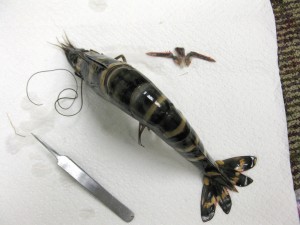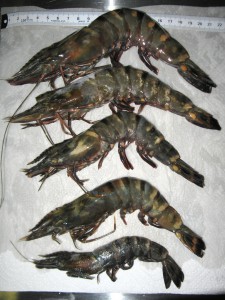The Asian Tiger Shrimp (Penaeus monodon) have been reported across the northern Gulf of Mexico for several years now but unlike Cogon grass, Chinese tallow, and Lionfish they have not really made the press. We know they are there, but captures in shrimp trawls seem to be infrequent… it just does not look like a serious problem.
But now there is a study being conducted by Dr. Jennifer Hill (Louisiana Tech University) that sheds a little light on the impacts of this new invasive species. Working out of Dauphin Island Sea Lab, and funded by Mississippi-Alabama Sea Grant, her study is looking at the interactions between the tiger shrimp and our native species – the white and brown shrimp.
Tiger Shrimp as Predators
Dr. Hill has discovered that tiger shrimp do not prefer salt marshes, as our native species do. They are apparently too large, ranging between 8 and 10 inches – some as large as 14 inches, and prefer more open environments. Tiger shrimp may prefer seagrass beds, another haunt for local shrimp, but she is not sure at the moment. She has noticed that when tiger shrimp are around the native shrimp move towards structure. This is to avoid predation by tiger shrimp, which do try and catch them – but they are not very good at it. Her study indicates that 80-90% of the native shrimp survive such attacks, but forcing the natives towards structure could impact the catch by our shrimpers.
Tiger Shrimp as Prey
Preferring open environments leaves tiger shrimp at a higher risk of predation. One thought is that their large size and dark color may not be recognized as a shrimp by local predators. One species that has shown interest in them are redfish. Dr. Hill has found that redfish will not hesitate to go after them, and may actually prefer them over white shrimp, but – because of the size of the tiger shrimp – it must be a large redfish.
Shrimpers in Alabama and Mississippi are currently selling the tiger shrimp they capture to Dr. Hill for her studies. She found that very few were captured in 2014, possibly due to the cold winter that year, but had plenty submitted in 2015. The mild winter of 2016 may produce a large number this summer. If you are shrimper in the Pensacola area, and interested in selling live tiger shrimp at $30 each, contact Dr. Hill at (251) 861-2141 ext. 2179.
- Our Environment: Part 4 – Life on Land - March 7, 2025
- Our Environment: Part 3 – Life in the Sea - February 21, 2025
- Marine Creatures of the Northern Gulf – Green Algae - February 14, 2025


